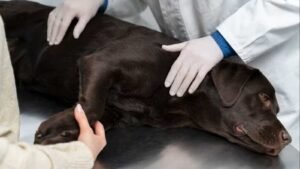Introduction
While your dog getting older, cloudiness develops within the crystalline lens, resulting in a cataract, which is caused by changes in water balance in the lens and is converted into protein inside the lens. Behind your dog’s iris, a mature cataract looks like a white disc. The area of the eye that is normally black will now appear white. A cataract is a condition in which the lens becomes opaque (cloudy), obstructing light passage. A cataract can be as small as a speck that barely interferes with vision or as severe as a composed entirely cataract that causes vision loss. Cataracts are more common in older dogs, but genetics play the most important role in whether a pet develops cataracts. Cataracts are more common in certain breeds, such as Boston terriers, cocker spaniels, Siberian huskies, and miniature poodles, and can occur as early as a year of age.
Treatment
Surgery, which is done under general anaesthesia, is the only efficacious way to recover vision in canines with cataracts. A technique called phacoemulsification can be used to remove cataracts in dogs. The cloudy lens or cataract in the dog’s eye is broken up and removed using an ultrasonic device, which is similar to the method used in human cataract surgery. Typically, veterinarians will tell you that surgery is the only way to prevent your dog from going blind.
The primary objective of treatment is to reduce the cloudiness or opacity from the canine lens and replace it with an artificial intraocular lens (IOL) in the lens bag. If an IOL cannot be implanted to help the eye concentrate light on the retina, your dog will be far-sighted but able to see.
What is the cause of cataracts?
Many dog breeds are predisposed to hereditary cataracts, which can develop as early as birth or later in young or middle-aged dogs. Hereditary cataracts in dogs should not be used for breeding. Diabetes, advanced age, trauma, and retinal disease are some of the other causes of cataracts. Cataracts may or may not progress to total blindness, depending on the cause. The degree of progression is frequently predictable and can be determined by a meticulous examination by a veterinary ophthalmology specialist. Your dog’s eyes may be discharged or runny. You might also notice him pawing or rubbing his eyes. Over time, he may appear clumsy, bump into things, and require assistance getting around.
If you notice these symptoms in your dog, please visit maxvet or contact us so that we can treat them properly.


